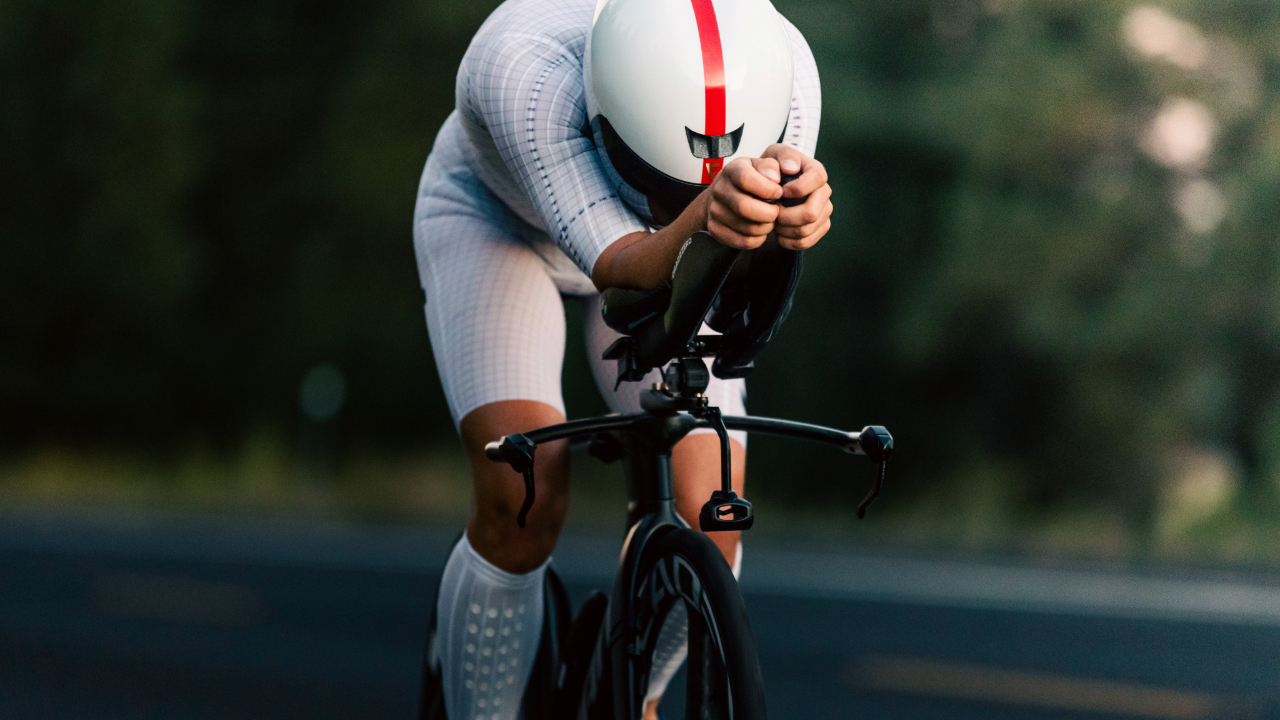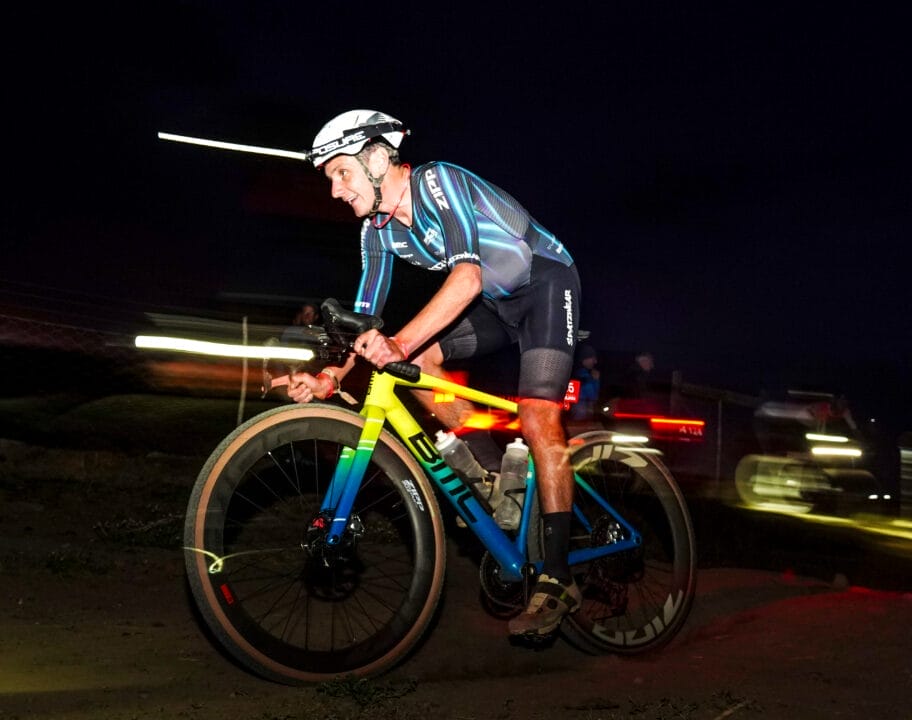Maybe you’re chasing a PR at your next cycling time trial. Or maybe you’re just fed up of getting dropped on the group ride! Plenty of us want to get faster on two wheels. And while for the most part, if you want to ride faster you’re going to have to train smart and push yourself to improve your fitness. There’s a strong chance you’re not making the most of your existing cycling fitness. Depending on the terrain you’re riding on, aerodynamics can make a significant difference to your average cycling speed.
Optimising your bike set up and kit choices to reduce drag can help you to unlock ‘free’ speed on the bike, and get the most out of your current cycling fitness. And while a few watts saved here and there might not sound that significant, those aero gains can actually add up to significant time – and energy – savings over longer distances.
We take a look at how you can improve your aerodynamics on the bike to ride faster for the same amount of effort.
How to get more aero on the bike to improve your speed
Before we get into the more costly realms of upgrading your wheelset – or even having an N+1 moment and getting a brand new bike. Let’s first take a look at some of the lower cost, ‘easy win’ adjustments you can make to optimise your existing bike set up.
Improve your bike position
One of the most effective changes you can make to be more aero on the bike is taking the time to improve your cycling position. When we talk about being ‘more aero’ we’re actually talking about reducing how much drag we create, and therefore how much resistance from the wind we have to overcome to move forward. And your body is said to create approximately 80% of all drag. So finding the most effective body position is key.

In the past, finding the most aero cycling position would need to involve a trip to the wind tunnel. But there’s now new technology out there which allows you to test your aerodynamics out in the real world. Body Rocket have developed on-the-bike aero sensors which isolate the rider and calculate how much drag your body creates in different positions.
“What we’ve done is take the concept of a wind tunnel, shrink it, and put it onto a bike. Essentially, we’ve moved the wind tunnel into a real-world scenario… We typically see a 15-20 watt saving in the first session [with Body Rocket] just by tweaking positions. Equating to significant time savings over various distances.”
– Matthew Hutchings, Body Rocket
By doing this testing in real-world settings, you can test out multiple options without needing to keep going back to a wind tunnel. And you also find the most aero position taking into account how you shift around on the bike as you go round corners or get hit with an unexpected gust of cross wind.
Resist the temptation to go too aggressive with your riding position
When you’re looking at making changes to your cycling position. It’s important that you balance aerodynamics with comfort and practicality. It’s no use being ultra-aero if you can’t push power or you have to sit bolt upright after a few minutes because the position is too aggressive and uncomfortable to hold for the full distance.
Test out different positions to find the sweet spot that balances aerodynamics with efficiency and comfort.
Upgrade your bike helmet
When you’re cycling, your head makes up a significant portion of the frontal area presented to the wind. And so your bike helmet choice has an impact on how the air flows over you, and therefore how much drag is created.
Aero road helmet vs aero TT helmet – how much difference does a TT helmet make?

Time trial (TT helmets) are typically larger helmets, with a visor across the front. They’re designed to be as streamlined as possible. But let’s face it, they make you look a bit like you’ve turned up dressed as a Storm Trooper. So is it worth losing style points to make aero gains?
We headed to an outdoor velodrome and used the Body Rocket system to test out the difference between an aero road cycling helmet, and an aero time trial helmet in terms of reducing drag and time saved over 180km on the bike. In this instance, we tested out the Specialized S-Works Evade 3 road cycling helmet versus the Giro Aerohead TT helmet.

You can see from the screen grab above that once we’d found the most aero position, switching to the Giro Aerohead TT helmet reduced the CdA by a further 0.007. That might not sound like much, but over 180km, that would be equivalent to riding 3 minutes and 33 seconds faster just by switching the helmet!
Wear aerodynamic cycling gear
If you tend to go for cycling gear with a more casual fit, embracing the Lycra life can help you to reduce drag and ride faster. And if you’re already opting for close-fitting cycling kit, you can take the aero gains even further by switching to a time trial-specific speed suit. These are extremely tight fitting, and they’re made using materials that are specifically designed to reduce drag and optimise airflow.
Calf sleeves and shoe covers
Alongside your race suit, you could also consider using calf sleeves/calf guards. It depends which brand you look at, but on average aero calf sleeves are said to save you between 5-8 watts on the bike by reducing drag.
Something that we tend to overlook when it comes to optimising our aerodynamics is our choice of shoes on the bike – but depending on the design, your cycling shoes can actually create a fair amount of drag. Using shoe covers can help to reduce this.
Water bottles and nutrition storage
How you carry your fluids and nutrition on your bike frame can have a big impact on its aerodynamics. You don’t want to spend a small fortune on an aero bike frame, only to load it up with bottles and gels that cancel out those aero gains!
If your bike doesn’t come with a built-in hydration system, consider using after-market aero hydration systems which fit to the front of the bike and help to optimise air flow. If you’re putting bottles on your down tube, avoid large round bottles that will disrupt air flow and go for the aero-shaped options instead if you want to save every watt possible.
Many TT bikes now have built-in frame storage for nutrition. If yours doesn’t and you’re racing longer time trials that mean you need additional fuel beyond what you can mix in your bottles. Look at aero pouches and bento boxes that fit to your top tube, rather than having your nutrition strapped here there and everywhere on your frame.
Aero bike upgrades
Fine-tuned all the easy wins and still on the hunt for more aero gains? This might be the excuse you’re looking for to have an N+1 moment and upgrade your bike. If you’re currently using a road bike, then you might consider upgrading to a time trial bike. The frames on these bikes are designed to be as aero as possible. And even if you’ve had clip-on aero bars on your road bike. The adjustability of the TT bike will allow you to get into a more aero position with improved comfort.
You can also look at upgrading your bike wheels. Deeper section rims are more aerodynamic because they improve airflow, and increase side force. A disc wheel on the back also has the added benefit of acting like a ‘sail’ of sorts in a cross tail wind, helping to propel you forward. If a full disc wheel is out of budget, you can explore lower cost options like disc wheel covers. These still offer pretty good watt-savings, they’re just slightly heavier than running a full carbon disc wheel.
Reducing your CdA and optimising your aerodynamics will help you to cycle faster for the same effort and power output. But of course, if you want to get significantly faster – you’ll need to level up your training too! Focus on raising your cycling FTP with targeted interval sessions. Improving your overall aerobic fitness, so you can ride faster for longer. And take some time – particularly over the winter months – to work on your bike handling skills, so you can take corners faster and descend with more confidence. Off road riding is a great way to do that. Excuse to buy a new gravel bike, anyone?




